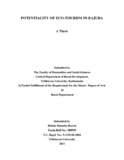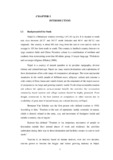Please use this identifier to cite or link to this item:
https://elibrary.tucl.edu.np/handle/123456789/887| Title: | Potentiality of Eco-Tourism in Bajura |
| Authors: | Rawat, Birkha Bahadur |
| Keywords: | Eco-tourism;tourism industry;rural development |
| Issue Date: | 2011 |
| Publisher: | Department of Rural Development |
| Institute Name: | Central Department of Rural Development |
| Level: | Masters |
| Abstract: | “God’s earth in all its fullness and beauty is for the people”– Thomas Cook. By following this statement tourism industry has seemed to be a second largest industry in the world it contributed by 944 billion US$ in global economy from 920 million international tourist activities. It has seed that 684 million tourist involved in 2000, 920 million in 2009 and predicted 1.6 billion in 2020. Spain and Singapore are such a country which solicited tourist greater than hosts annually that was 36 million population and 40 million tourist in Spain 1981. Nepal has also earned to 287 million revenue through more than ½ million tourist activities in 2008. It has contributed 2.3 percent in GDP. But it is less than Spain (12%) and (7%) in France and Singapore. Although here in Nepal, there is no doubt that potentiality of tourism development is huge in amount. While realizing it's natural beauty and smiling rural people. Thus, without development and promotion of tourism rural development is impossible and without rural development overall development is quite impossible in that sense. Nepal as an attractive, pleasing safe and unique destination in global tourism map through conservation and promotion of natural, cultural, biological and human made heritage is the fundamental base of rural development through tourism in Nepal. In this regard, this present research study entitled "Potentiality of Eco-tourism in Bajura District: A Case Study of Bajura District" has been carried out with the objective, analyzing the area as a potential eco-tourism destination, about which many tourists don't know much till date. The main objective of the study is to analyze the potentiality of the eco-tourism development and identify the elements that can contribute to the development of eco-tourism in study area. To carryout the objective, according to social science research methodology 95 sample population were selected purposive sample random from each 27 VDC likewise 7 hotel owner and 21 tourist were also selected for information. From research study in was found that, this district has several aspects of eco-tourism products. The study has regarded highly potential for the promotion of eco-tourism because this district is rich in cultural and natural heritage it consists greater than 5000 plant spices greater than 1500 animal spice, assumed Budhinanda Lake (lies in the highest position in the world) and Badimalika temple, Khaptad National Park, Majestic Mountain etc. It is culturally and naturally significant where diverse ethnic groups, monuments, other temple are standing and surveying from long time. The Bajurali culture is the prominent cultural attraction for tourist and natural beauty of the Bajura also assisting in eco-tourism development. The selected district has great potentiality to attract tourists but is not given due consideration by related agencies and government. Most of the aspects of eco-tourism are rural, Cultural, Village, Adventure, sport, Honeymoon, agro-eco tourism etc. have found to be great potentiality there. MOCTCA has recently decided for decided for established tourism promotion in Karnali Chisapani (Thakur Dwar) to address the great potentiality of tourism development middle far- western regions which should be consider as a remarkable step. If the tourism promoted in this district it would be significant strategy for rural transformation which finally contributes for respect rural living standard, sustainable development in general and rural development in particular. |
| URI: | http://elibrary.tucl.edu.np/handle/123456789/887 |
| Appears in Collections: | Rural Development |
Files in This Item:
| File | Description | Size | Format | |
|---|---|---|---|---|
| cover.pdf | 30.94 kB | Adobe PDF |  View/Open | |
| CHAPTER I.pdf | 280.49 kB | Adobe PDF |  View/Open |
Items in DSpace are protected by copyright, with all rights reserved, unless otherwise indicated.
